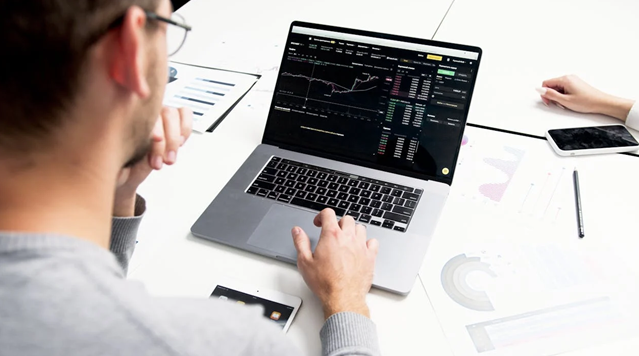
5 Ways to Balance Technical Indicators With Self-Assessment
In trading, success is often a blend of technical skills (choosing the right trading strategies) and self-awareness. While technical indicators provide the data-driven foundation for decision-making, a trader's psychological state can have as much, if not more, impact on results. The real challenge is finding the balance between relying on cold, hard numbers and keeping emotions in check.

In this post, we'll explore five ways traders can effectively balance technical indicators with self-assessment to achieve consistent, better trading outcomes.
1. Know the Role of Technical Indicators for better technical analysis
Technical indicators like moving averages, volume analysis, and VWAP offer critical insights into price action, trends, and market sentiment. They are designed to help traders interpret the financial markets more clearly by filtering out the noise of price fluctuations. But here's the catch: technical indicators should never be used in isolation nor as a crutch for market understanding.
Each indicator has its limitations. For instance, a moving average might tell you about a trend but won't account for sudden news or significant market shifts. The key is to use a small set of indicators that complement your trading style without overwhelming you. For example, a simple 5 EMA combined with volume can balance trend-following and understanding price momentum without clouding your decision-making process.
Pro tip: Avoid using too many indicators. Keeping it simple prevents confusion and over analysis, allowing you to focus on price action and key signals. You may have heard the saying, "Information is King." Well, too much information can be Medusa, paralyzing you from making any decision. Keep it simple and balanced with your ability to process information quickly.
2. Self-Assessment: The Missing Piece

While technical indicators tell you what the stock market is doing and market trends, self-assessment helps you understand what you are doing. A major factor in trading is your mindset. Traders often face emotional highs and lows — excitement, frustration, fear, greed — and these emotions can interfere with otherwise sound technical decisions.
Ask yourself these key self-assessment questions before and after each trade:
• Am I following my plan or making impulsive decisions?
• Did I enter or exit too early or late due to fear or greed?
• How am I reacting to wins or losses?
• Am I mentally ready to trade today?
Self-awareness helps you identify emotional biases that can cloud your judgment and lead to poor trading outcomes. Recognizing your mental state in real-time is as critical as reading price charts. When we are out of touch with our emotions and their impact on our choices and behaviours, we behave like a computer with a virus that behaves in unpredictable, often disruptive ways.
3. Finding the Balance
So, how do you balance the objectivity of technical indicators with the subjectivity of your emotions? The answer lies in combining both approaches.
Use technical indicators to validate signals: Before entering a trade, make sure your indicators confirm what you see in the market. But also check in with yourself: are you feeling rushed, overconfident, or fearful? If so, this might not be the best time to trade, no matter what the charts say.
Keep a trading journal: This is an excellent tool for balancing technical analysis and self-assessment. For every trade, document your technical reasons, emotional state, thoughts, and feelings. Over time, you'll begin to see patterns. For instance, are you more likely to avoid your plan when feeling anxious? Does overconfidence lead you to ignore risk management?
Reviewing your journal regularly allows you to gain insight into how your emotions affect your trades and learn to make better decisions.
Pro tip: Recording your journal in real-time is most effective. Yes, it slows things down, but that's good for a few reasons. First, it gives your amygdala (the small almond-shaped thingy in your brain that engages your fight or flight response) enough time to disengage, which takes about six seconds, allowing your rational side time to regain control. Secondly, real-time journaling provides more accurate recall of events, feelings, and thoughts, which will benefit you in the long run—finally, real-time journaling forces you to be more self-aware, which builds your habit.
4. Develop a Feedback Loop
After each trading session, review both the technical aspects and your emotional behaviour. Did your indicators work as expected? Did you stick to your plan, or did emotions like greed or frustration cause you to deviate?
You can even create a simple scoring system to evaluate your performance. For example, assign yourself points based on whether you followed your plan or let emotions guide your actions. Over time, this feedback loop will help you recognize when you're most vulnerable to emotional trading and allow you to adjust accordingly.
5. Set Rules for Self-Assessment-Based Pauses

No matter how strong your technical skills are, there will be times when your emotions are running the show. Maybe you've had a string of losses and are frustrated, or perhaps a big win has left you overconfident. When you feel your emotions taking over, it's time to pause. After most losses, I deliberately shut down my trading terminal, particularly if I find emotions attached to them. This forces a pause for me and guarantees that my next trade is not inspired by revenge.
Create a rule for yourself: if you recognize that you're trading out of frustration, excitement, or fear, take a break. Even a short pause — stepping away from the charts for 15 minutes or an hour — can help you regain focus and perspective.
Conclusion
Balancing technical indicators with self-assessment is vital for traders seeking long-term success. While technical analysis gives you the data-driven insights you need, self-assessment keeps you grounded and prevents emotional biases from taking over.
You can make more informed, disciplined trading decisions by using a minimal set of indicators, regularly assessing your mindset, and developing a feedback loop between your trades and emotions. Remember, successful trading is not just about reading the charts — it's also about reading yourself.
Ready to level up your trading skills? Join our community for more trading tips, psychology insights, and actionable steps to help you become a more consistent trader.
Subscribe to receive notifications when a new blog post is available, and start improving your trading today!



